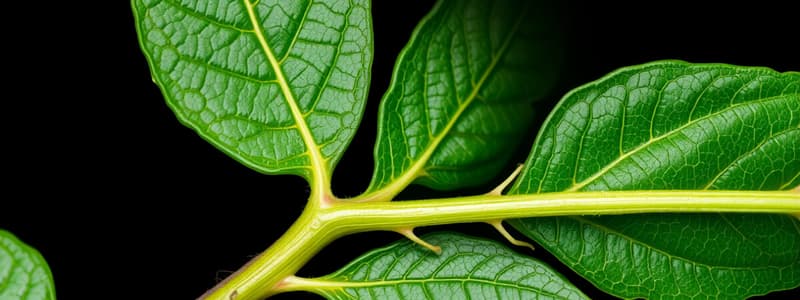Podcast
Questions and Answers
What type of tissue is composed of more than one type of cell and coordinates to perform a common function?
What type of tissue is composed of more than one type of cell and coordinates to perform a common function?
- Connective tissue
- Simple permanent tissue
- Complex tissue (correct)
- Epithelial tissue
Which of the following is NOT a component of xylem tissue?
Which of the following is NOT a component of xylem tissue?
- Xylem parenchyma
- Xylem fibres
- Sieve tubes (correct)
- Tracheids
How do xylem and phloem differ in terms of material transport?
How do xylem and phloem differ in terms of material transport?
- Xylem conducts tissue is absent in complex plants; phloem is dominant
- Xylem transports materials in both directions; phloem transports vertically
- Xylem transports food; phloem transports water
- Xylem transports water and minerals vertically; phloem transports food bidirectionally (correct)
Which function is primarily associated with the parenchyma in xylem tissue?
Which function is primarily associated with the parenchyma in xylem tissue?
Which of these options correctly identifies a type of cell found in phloem?
Which of these options correctly identifies a type of cell found in phloem?
What is a key characteristic of complex tissues in plants?
What is a key characteristic of complex tissues in plants?
In which type of plant tissue do tracheids and vessels belong?
In which type of plant tissue do tracheids and vessels belong?
Which type of cells in phloem are known for their perforated walls?
Which type of cells in phloem are known for their perforated walls?
Flashcards are hidden until you start studying
Study Notes
Types of Tissues
- Tissues consist of cells similar in structure, known as simple permanent tissue.
- Complex tissue is composed of multiple cell types that work together for a common function.
Conductive Tissues
- Xylem and phloem are examples of complex tissues functioning as conducting tissues.
- These tissues form a vascular bundle, which is essential for plant survival in terrestrial environments.
Xylem
- Composed of tracheids, vessels, xylem parenchyma, and xylem fibers.
- Contains thick-walled cells, with a majority being dead.
- Tracheids and vessels are tubular, facilitating the vertical transport of water and minerals.
- Parenchyma serves to store food and aids in lateral water conduction.
- Fibers provide structural support.
Phloem
- Made up of sieve tubes, companion cells, phloem fibers, and phloem parenchyma.
- Sieve tubes are tubular cells distinguished by perforated walls.
- Unlike xylem, phloem allows for the bidirectional movement of materials, transporting food from leaves to other plant parts.
Studying That Suits You
Use AI to generate personalized quizzes and flashcards to suit your learning preferences.




